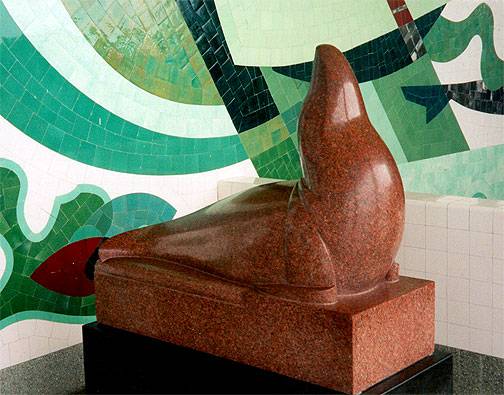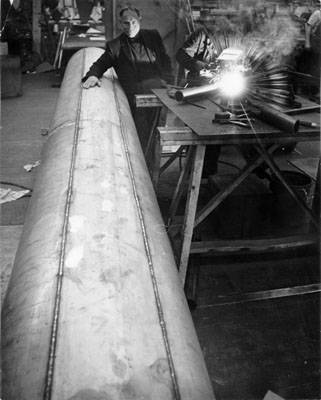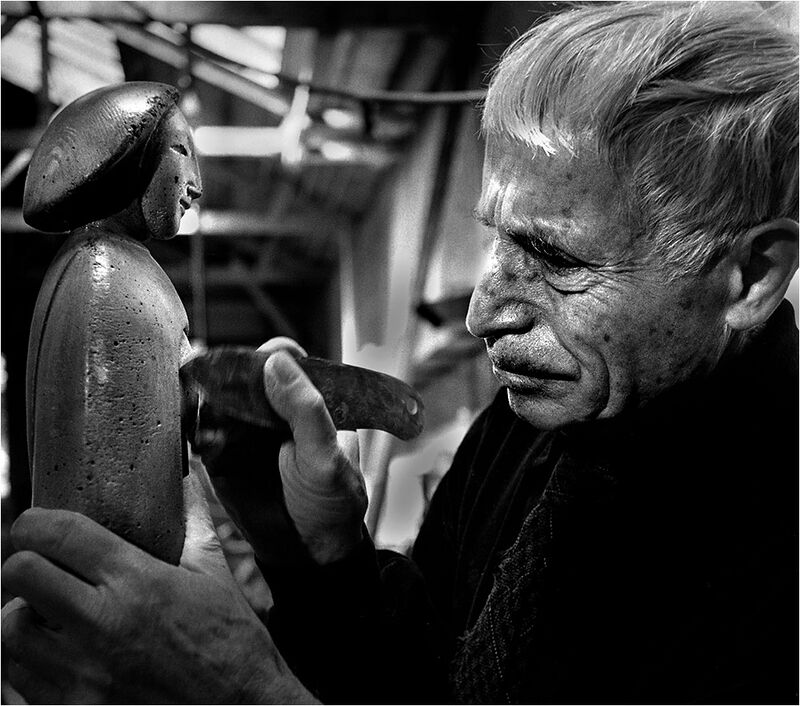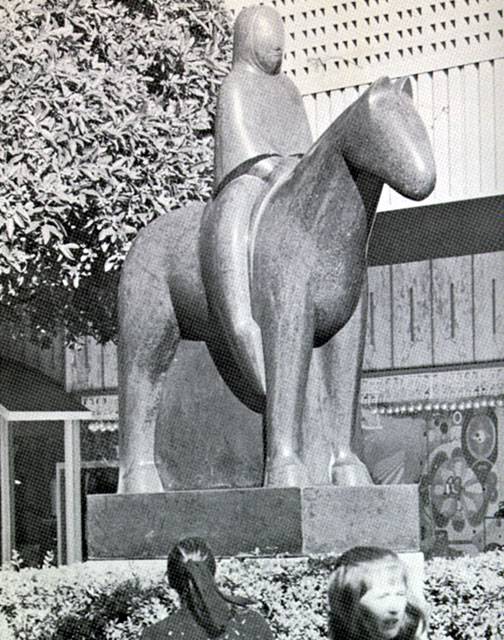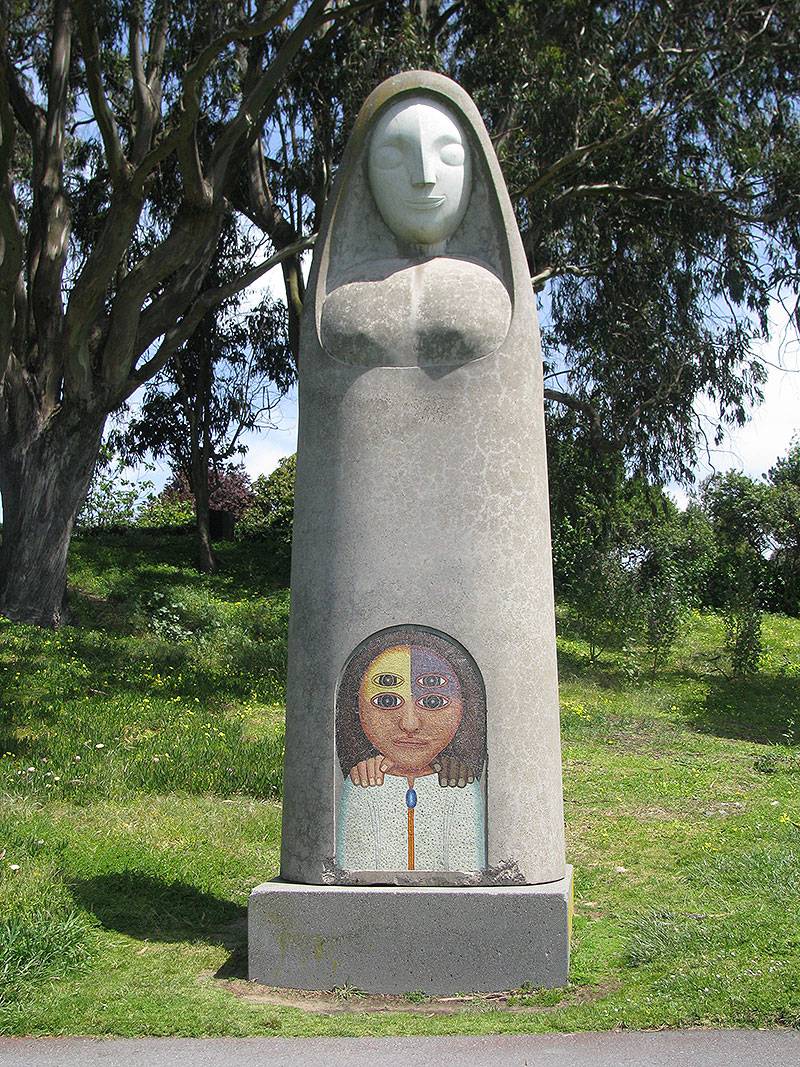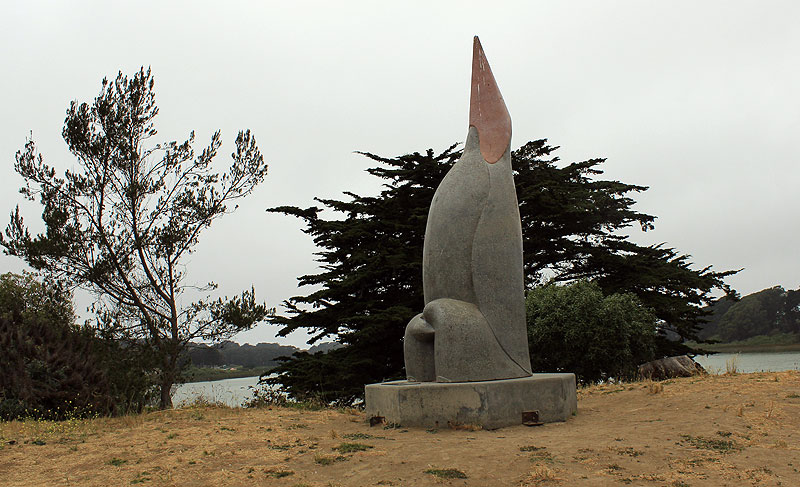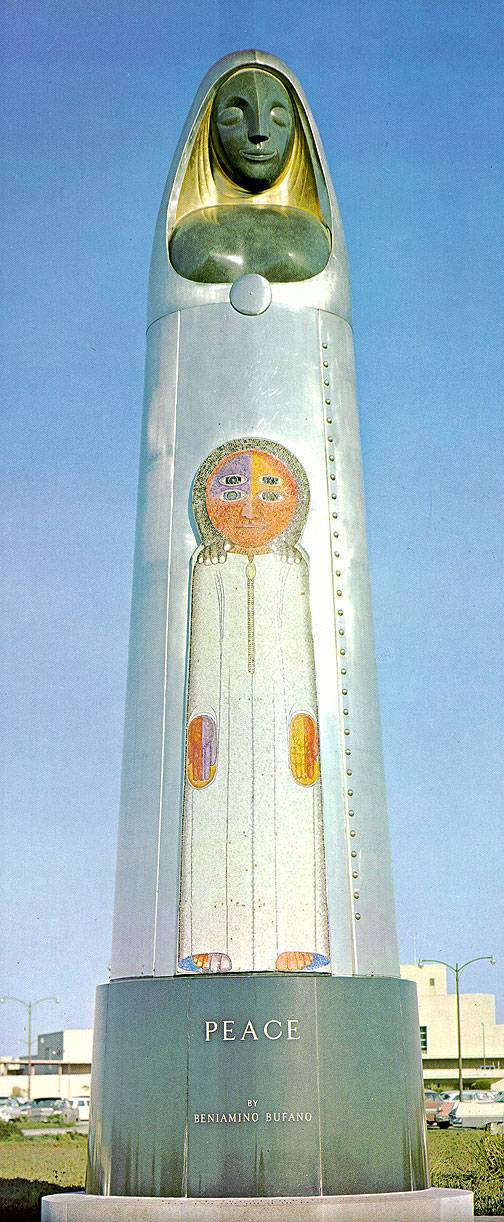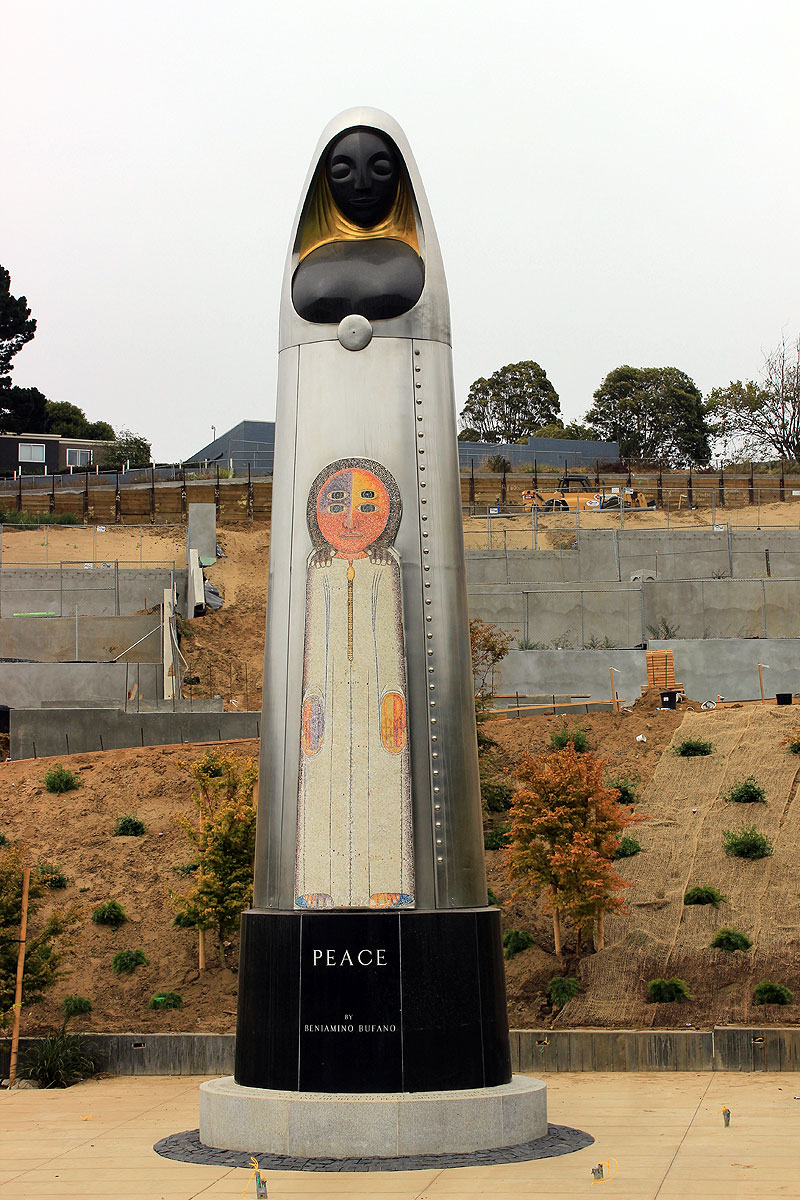Beniamino Bufano on Public Art: Difference between revisions
No edit summary |
added Ted Kurihara photos |
||
| (6 intermediate revisions by 2 users not shown) | |||
| Line 16: | Line 16: | ||
'''Seal at Maritime Museum''' | '''Seal at Maritime Museum''' | ||
''Photo: Chris Carlsson'' | ''Photo: Chris Carlsson'' | ||
| Line 32: | Line 26: | ||
''Photo: San Francisco History Center, SF Public Library'' | ''Photo: San Francisco History Center, SF Public Library'' | ||
[[Image:Ted-Kurihara-Benny-Bufano-March-24-1968 0205-b-024a-copy.jpg|800px]] | |||
'''Benny Bufano in his workshop, March 24, 1968.''' | |||
''Photo: © [https://tedkuriharaphotography.com/ Ted Kurihara]'' | |||
[[Image:Ted-Kurihara-Bufano 0205-b-003-copy.jpg|310px|left]] [[Image:Ted-Kurihara-Benny-Bufano-w-bear 0205-e-001-copy.jpg|310px|right]] | |||
''Photos: © [https://tedkuriharaphotography.com/ Ted Kurihara]'' | |||
Bufano was a very strong voice for social change in America. He produced art that advocated resistance to oppression. "I sculptured 'Peace' in the form of a projectile, to express the idea that if peace is to be preserved today it must be enforced peace-enforced by the democracies against Fascist barbarism. Modern warfare, which involves the bombing of women and children, has no counterpart in a peace interpreted by the conventional motif of olive branches and doves." (O'Connor 1973) | Bufano was a very strong voice for social change in America. He produced art that advocated resistance to oppression. "I sculptured 'Peace' in the form of a projectile, to express the idea that if peace is to be preserved today it must be enforced peace-enforced by the democracies against Fascist barbarism. Modern warfare, which involves the bombing of women and children, has no counterpart in a peace interpreted by the conventional motif of olive branches and doves." (O'Connor 1973) | ||
| Line 38: | Line 42: | ||
'''St. Francis on horse.''' | '''St. Francis on horse.''' | ||
[[Image:Bufano-Madonna-at-Ft-Mason-2010 6698.jpg]] | |||
'''Bufano Madonna overlooking the Great Meadow at Fort Mason, 2010.''' | |||
''Photo: Chris Carlsson'' | |||
[[Image:Penguins-prayer-Bufano-at-Lake-Merced-2014 2856.jpg]] | |||
'''Penguin's Prayer at Lake Merced, 2014.''' | |||
''Photo: Chris Carlsson'' | |||
[[Image:Bufpeac.jpg]] | |||
'''Statue of Peace in its original installation at SF Airport, c. 1960s.''' | |||
''Photo: Chris Carlsson'' | |||
[[Image:Ted-Kurihara-Benny-Bufano-3-24-1968-0205-a-004-copy.jpg|800px]] | |||
''Photo: © [https://tedkuriharaphotography.com/ Ted Kurihara]'' | |||
[[Image:Bufano-Peace-statue-on-Brotherhood-Way-2014 2851.jpg]] | |||
'''The Peace statue was relocated to Brotherhood Way near SF State, seen here in 2014.''' | |||
''Photo: Chris Carlsson'' | |||
[[Sargent Johnson and His Milieu | Prev. Document]] [[Public Arts Programs in the 1930s | Next Document]] | [[Sargent Johnson and His Milieu | Prev. Document]] [[Public Arts Programs in the 1930s | Next Document]] | ||
[[category:Public Art]] [[category:1930s]] [[category:1970s]] | '''Enjoy an [https://www.google.com/maps/d/u/0/viewer?mid=1lgLl5Rb8EqwUtdXROWzHBVWxsVpEzg4p&hl=en&ll=37.76264777129591%2C-122.38913931610405&z=12 evolving map of sculptures by Beniamino Bufano in San Francisco] created by Paul Hays''' | ||
[[category:Public Art]] [[category:1930s]] [[category:1960s]] [[category:1970s]] [[category:OMI/Ingleside]] [[category:North Beach]] [[category:Marina]] | |||
Latest revision as of 20:45, 25 February 2024
Historical Essay
by Tommy L. Lott, Excerpted from "Black Consciousness in the Art of Sargent Johnson," in Reclaiming San Francisco: History, Politics, Culture, 1998.
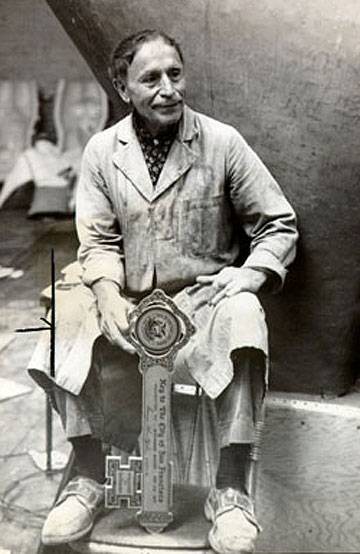
Benny Bufano, 1963
Photo: San Francisco History Center, SF Public Library
In his essay on public art, Bufano presents a philosophy of contemporary art that is thoroughly political (O'Connor 1973). Bufano maintained that art must become democratic by being "big enough to belong to everybody, too big for anyone to put in his pocket and call his own." Rather than produce art to fit over some patron's fireplace, he invoked a notion of public art that is created for the benefit of the masses. He maintained that the function of art is to create a universal culture that will guide the future course of world destiny to a better way of living. When Bufano spoke of guiding the future course of world destiny he assigned a political role to artists in combating the rise of fascism and modern warfare.
Unlike Sargent Johnson, who is reported to have shrewdly studied the tastes of patrons by working in an art gallery in order to meet them, Bufano maintained an anti-patron stance. He quoted the "whining complaint and recrimination" in a letter he received from an ex-patron to illustrate the need for artists to be less dependent on patrons to survive. The patron was incensed at Bufano for proposing a monumental St. Francis made of stainless steel and copper overlooking the bay, insisting instead that Bufano's best work was represented by his little statues of children, rabbits, deer, and puppies. Bufano then asked, "How can such a man understand the Sun Yat-sen or the Statue of Peace?" "How can a cultural pattern be developed for America if art and the artists are subjugated to the whims and idiosyncrasies of a few overfed decadent merchant princes, carryovers from the days of feudalism?" (O'Connor 1973)
Seal at Maritime Museum
Photo: Chris Carlsson
Rather than capitulate to the economic pressure of survival, Bufano advocated the radical practice of offering his service to any community that could simply pay him day wages and supply the materials. He wanted to produce art for the masses with materials and designs that "reflect public service and functional objectives." He maintained that public art allows artists to give something to the world and enables their voices to be heard beyond the provincialism of their immediate locales.
Bufano in his workshop, 1962.
Photo: San Francisco History Center, SF Public Library
Benny Bufano in his workshop, March 24, 1968.
Photo: © Ted Kurihara
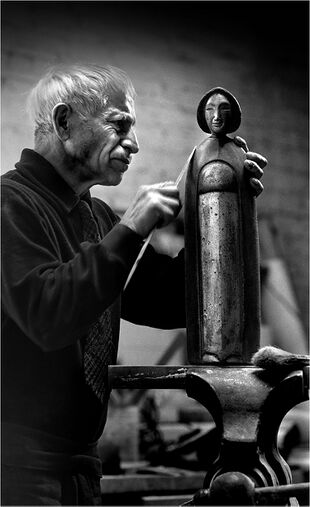
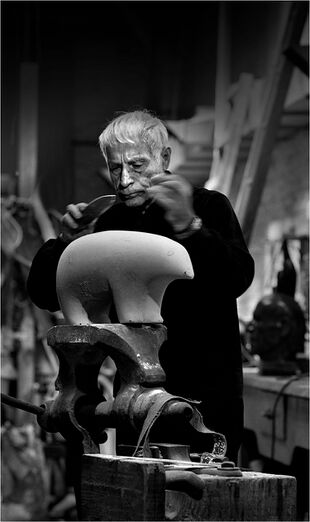
Photos: © Ted Kurihara
Bufano was a very strong voice for social change in America. He produced art that advocated resistance to oppression. "I sculptured 'Peace' in the form of a projectile, to express the idea that if peace is to be preserved today it must be enforced peace-enforced by the democracies against Fascist barbarism. Modern warfare, which involves the bombing of women and children, has no counterpart in a peace interpreted by the conventional motif of olive branches and doves." (O'Connor 1973)
St. Francis on horse.
Bufano Madonna overlooking the Great Meadow at Fort Mason, 2010.
Photo: Chris Carlsson
Penguin's Prayer at Lake Merced, 2014.
Photo: Chris Carlsson
Statue of Peace in its original installation at SF Airport, c. 1960s.
Photo: Chris Carlsson
Photo: © Ted Kurihara
The Peace statue was relocated to Brotherhood Way near SF State, seen here in 2014.
Photo: Chris Carlsson
Enjoy an evolving map of sculptures by Beniamino Bufano in San Francisco created by Paul Hays

